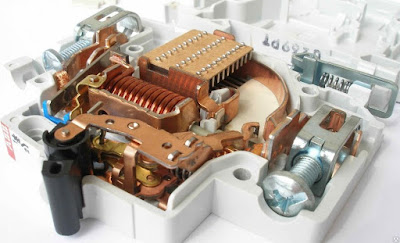Unfortunately, even the most perfect wiring or the most expensive electrical equipment will soon show a malfunction or fail. And if the circuit breaker is "knocked out", and after re-enabling the situation is repeated, then a short, but very useful algorithm, given below, will help determine the cause.
Why does the circuit breaker break
Standard circuit breaker (not differential circuit breaker) there are three reasons why it can be knocked out:
- Prolonged heating of a node or an entire line. Then a thermal release is triggered – a bimetallic plate in the middle of the device.
- Short circuit. At short circuit, the electromagnetic coil works and the bagger knocks out almost instantly.
- Due to a malfunction of the device itself. But then the machine can not be turned on at all – the lever is simply not fixed in its place.
If the short – circuit time of the circuit breaker does not exceed a few milliseconds, then a fairly long time interval may pass during heating-several tens of minutes. This data will significantly help with the initial diagnosis.
How to determine the reason why the circuit breaker is triggered
A simple algorithm will help you find the fault:
- Determine what kind of machine knocks out. If this is an input device, then most likely the reason for the excessive load is the simultaneous activation of several powerful consumers (hob, boiler, washing machine). Or the reason is in the wiring from the introductory bag to the next group of machines (for example, the wire "breaks" on the body of the shield).
- If the machine is not introductory, then you need to determine which line it supplies power to. See what exactly does not work in an apartment or private house when it is disabled.
- Replace the triggered device with a known good one.
- Turn on the machine and mark the time after which it will work: if almost instantly – a short circuit, after a while-gradual heating.
- Disable all consumers of the affected line and re-enable the machine.
- If the bag is knocked out again, you need to check the quality of the connections in the sockets. Very often, it is at the point where the socket is connected that the phase wire comes into contact with the zero one, which gives this effect for the circuit breaker.
- Еhe Circuit breaker is still knocking out – it's time to move on to checking the junction boxes. Due to poor contact and improper installation, the wires are gradually heated, the insulation is melted, and all the conductors are soldered together.
- If the machine still works, the possible reason is the contact of conductors inside the wall. To find the fault in this way, you will need the services of a qualified technician.
 |
| A burnt arcing chamber in the machine may cause the device to be triggered incorrectly |





